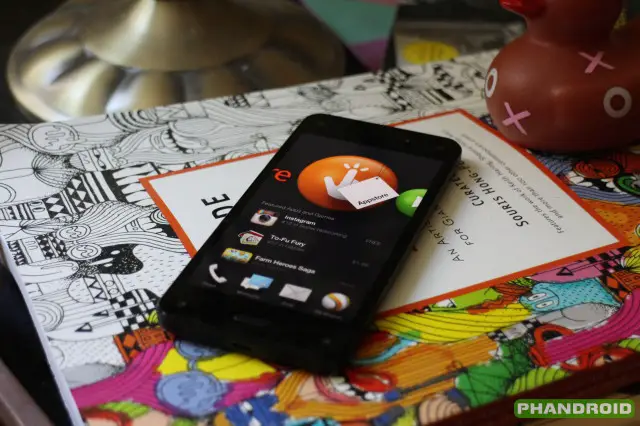
Amazon’s long-rumored smartphone has finally arrived in the form of the Fire Phone. The pseudo-Android smartphone shows its maker’s touch with heavy leanings toward Amazon digital content and features like Firefly that aim to keep consumers embedded squarely in the retailer’s ecosystem. Dynamic Perspective breathes some life into an otherwise flat Fire OS, but is the average hardware worth the $600+ price tag? Read on for our full review!
Build & Design
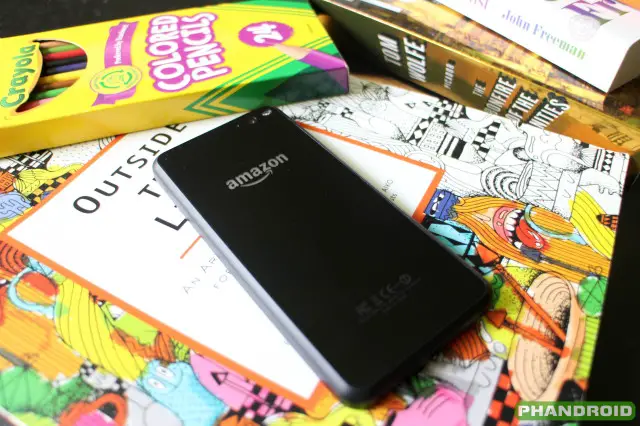
The Amazon Fire Phone is unique for many reasons, but its design hardly tops that list. At first glance, Amazon’s debut smartphone seems as unassuming as any that has come before it, but closer inspection reveals there is slightly more to the Fire Phone’s design. What most will quickly notice are four front-facing cameras stationed around the device’s bezel, essential elements to what Amazon hopes will become a killer feature: Dynamic Perspective. But more on that later.
Aside from these additional imaging sensors, the phone takes on a rather nondescript appearance that borrows some design cues from devices like the iPhone (the overall shape of the phone) and Nexus 4 (it’s glass rear casing). The outer edges of the phone are covered in a grippy rubber material that adds an air of durability to the device but also manages to negate some of the premium feel imbued by the rear glass accent panel (which itself gains some durability by utilizing Corning Gorilla Glass 3).
The Fire Phone manages to feel a bit chunky despite measuring in at less than 9mm thick (0.35 inches) and has some heft to it with a weight that tops the scale at 160 grams (identical the HTC One M8). For comparison, the Samsung Galaxy S5 weighs in at 145 grams while the iPhone 5s weighs in at 112 grams.
Several hardware buttons are located around the phone, including the prerequisite power/standby switch and volume rocker, but the most intriguing is a hardware camera key that can be used to trigger the phone’s Firefly product identification service. There is also a home button mounted below the phone’s display.
All in all, Amazon hasn’t created anything particularly inspired here, hedging the phone’s success less on a stellar, interesting design and instead on an innovative software experience that attempts to seamlessly interface the handset’s hardware with the overall user experience.
Display
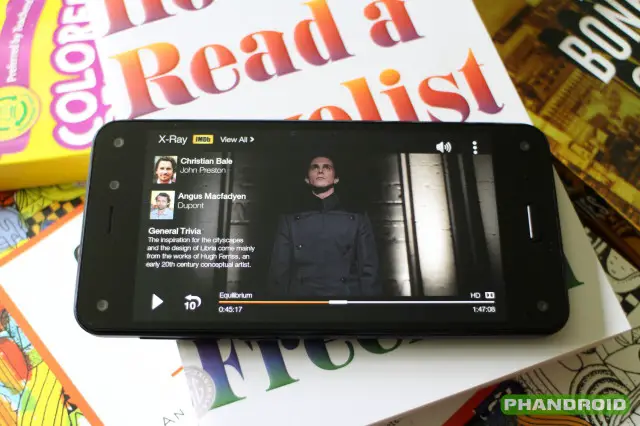
The Fire Phone sports a 4.7-inch IPS LCD display with a resolution of 1280×720 (312 ppi), but as with the design of the phone, it seems Amazon wasn’t overly concerned with making this aspect of their handset a tentpole feature. It’s an adequate display on par with most other midrange smartphones sporting 720p resolutions, but it will surely induce groans from those spoiled on the 1080p (and Quad HD) resolutions of most current Android flagship devices.
It’s a slight shame for a device so dependent on Amazon’s digital ecosystem. By default, consuming digital video content would be a logical focal point for an Amazon smartphone, but that doesn’t shine through with the Fire Phone’s display. Don’t get us wrong, the display performs well and many (especially those coming from the sub-HD display of the iPhone) won’t notice the missing pixels. Beyond resolution, the Fire Phone does a fine job reproducing images in terms of color and contrast.
That is to say: most users looking into picking up the Fire Phone won’t find the display a major turn off; it simply won’t provide that extra little bit of wow factor that has become the increasing concern of most other Android smartphone manufacturers (to be fair, the Fire Phone was never pitched as a straight up Android phone, either).
Hardware
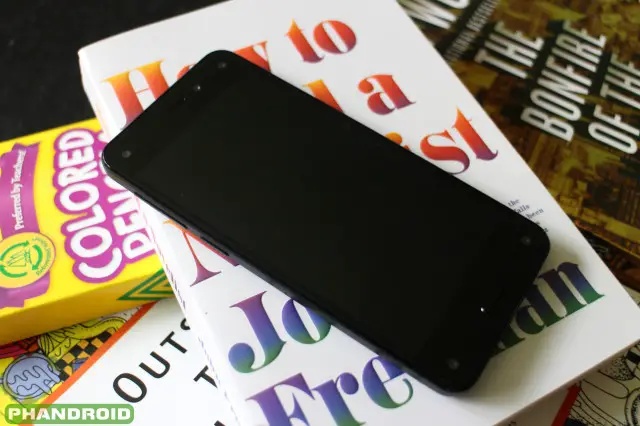
When it comes to hardware performance, the Fire Phone once again delivers an adequate experience without showing much sizzle. A Snapdragon 800 processor is the centerpiece, and it delivers for the most part. Benchmark tests obviously place the Fire Phone squarely below devices utilizing the new Snapdragon 801 processor (think LG G3, Samsung Galaxy S5), but those hard numbers don’t always tell the full story.
In the case of the Fire Phone, those numbers — though not spectacular — might still be a bit generous. The handset is slow to respond in many situations, especially when moving from a sleep to wake state and loading the Dynamic Perspective lockscreen. Bulkier apps can take some time to load, and you’re bound to miss out on a few shots waiting for the phone’s camera to launch (in such cases a few seconds can feel like an eternity). We were pleasantly surprised with how quickly Firefly could respond to input and identify products, however.
Whereas with a more lightweight configuration you might expect some impressive results from the Fire Phone, it is obvious here that Amazon has burdened the handset’s modest hardware compliment with a bulky Android modification and processor-intensive features like Dynamic Perspective. We might expect Amazon to address this in some way via a future software update, but for the time being expect some lag and the occasional application crash.
Software
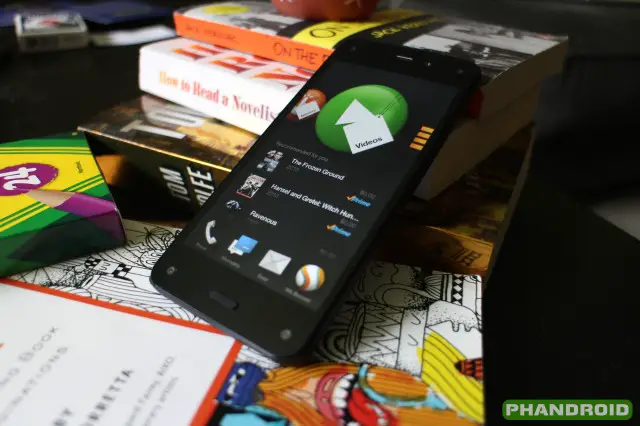
We can’t overstate one fact about the Amazon Fire Phone: this is not your typical Android phone. In fact, it makes no attempts to be anything remotely similar to any Android device before it. If it isn’t obvious upon first observing the phone’s widget-carousal homescreen arrangement then it becomes painfully clear upon realizing the total lack of Google services or access to the Play Store.
For the experienced Android user, this iteration of Amazon’s Fire OS (based on Android, but, as we said, almost nothing like Android) is at first confusing and then limiting. The “homescreen” setup provides several panes for quick access to Firefly, Amazon.com, Amazon Instant Video, and Amazon Music. You’ll notice the theme: the Fire Phone wants to keep you firmly in Amazon’s ecosystem. Apps are located by swiping up from the bottom of the screen to reveal the app drawer. And if you are seeking apps, you better be happy with the selection found in the Amazon App Store, because that’s what you get. Remember, there is no Google Play access on this device.
For an Amazon Prime member (and the phone comes with a free year of Prime for a limited time) with plenty of money invested in Amazon’s digital content, the Fire Phone makes a fine companion for accessing media and shopping for more. For users with their eggs in more than one shopping cart, however, it’s hard to reconcile the Fire Phone’s dependency on Amazon. But what did we expect? This is, after all, an Amazon phone produced by Amazon.
The software does gain two nifty features that have become the focal point of Amazon’s Fire Phone marketing materials: Firefly and Dynamic Perspective. Each has its pros and cons, and while both are a bit gimmicky they do add some basic value to the device.
Firefly
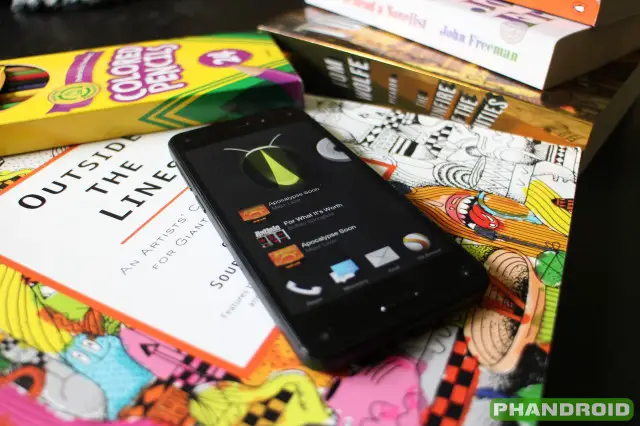
Firefly isn’t necessarily anything new. We have seen the image and sound ID functionality in countless apps like Google Goggles, Shazam, and even Amazon’s own offerings. What Firefly does, however, is take that functionality and shine a spotlight on it, making it a central part of the Amazon smartphone experience by including a hardware button to launch the service with one touch. It works surprisingly well, quickly pulling up information on scanned products and, yes, offering users the ability to purchase the item via Amazon.
The experience was seamless in most instances, able to pick out albums by their cover art, scan barcodes, pull audio from media. While Amazon’s big hope here is that Firefly will get you spending even more of your hard earned cash at their digital storefront, Firefly does illuminate additional info that makes it useful as a learning and discovery tool, as well.
The problem with Firefly is that it’s hard to imagine the feature becoming something users rely on. It is sure to get some use when comparison shopping and in those instances when you are dying to know what song is playing, but isn’t any reason to run out and by the Fire Phone right now.
Dynamic Perspective
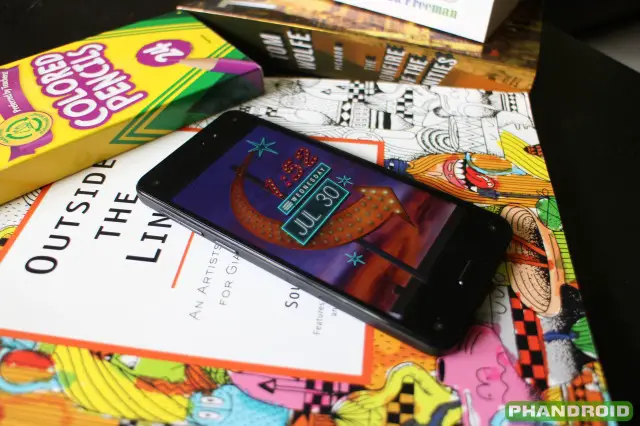
Rumors leading up to the unveiling of Amazon’s smartphone often mentioned that the company would be dabbling in three dimensions. What was ultimately announced as Dynamic Perspective is unlike the 3D smartphones we have seen previously, but ultimately no more useful.
Rather than go with an approach that sees imagery emerging from the screen via glasses-free 3D technology, Amazon decided to add the depth behind the screen. The initial result is something quite akin to iOS 7’s parallax view, but the Fire Phone doesn’t carry four additional front-facing cameras for nothing. There is certainly more depth to Dynamic Perspective than parallax view. The feature adds more than a dimensional background that shifts with the phone’s movements. It also is designed to enable users to “peek” around menu items and peer into new aspects of apps like Maps (and a couple of games as well).
Dynamic Perspective seeks to introduce natural user interface interactions by treating the phone’s screen as equal to three-dimensional space our eye normally operate in. The problem is, while the concepts of Dynamic Perspective are in fact very natural in the real world, our brains have been trained to treat the way we interact with a smartphone differently. The result is an experience that isn’t so natural, after all. Getting the most out of Dynamic Perspective involves consciously rethinking the way we approach interacting with a smartphone, for better or worse.
Some features were more useful than other, such as the ability to scroll web pages by tilting the phone. Even this is nothing new, and other manufacturers have been able to accomplish this without the need for added hardware. Does Dynamic Perspective represent a paradigm shift? Will it spark a revolution in the industry? It seems unlikely, and we wouldn’t be surprised if many users disabled the functionality in its current state (which is easily accomplished via the phone’s settings). We also wouldn’t be surprised to see the entire concept scrapped in future entries to Amazon’s smartphone lineup.
Battery
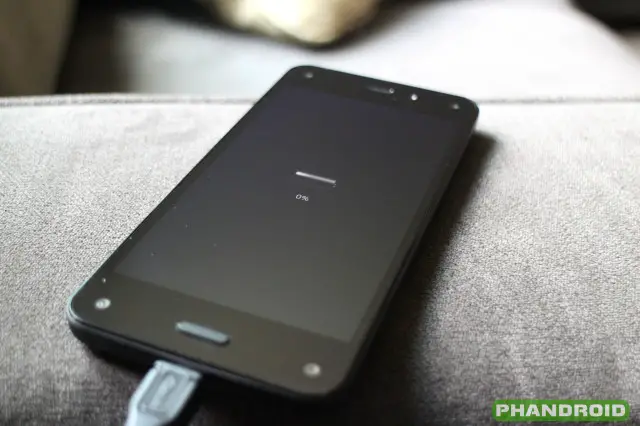
The Amazon Fire Phone carries a 2400mAh battery, but battery life was far from exceptional during our testing. You can expect average uptime on a single charge that should get you through the better part of a day, but keep a charger handy. We suspect the four cameras constantly monitoring the user’s interactions with the handset might have something to do with this. Throw in the more graphically intensive Dynamic Perspective as a whole and we might be on to something.
It doesn’t get much better if you use the Fire Phone as intended to consume streaming music and video. Operating the device as a media hub of sorts will quickly cut into battery life. While the Fire Phone fell short in several categories for us, the poor battery life is perhaps the least forgivable of the bunch.
Camera
While the Fire Phone’s camera is useful for scanning and searching products among Amazon’s catalog, it is more than simply a tool for taking advantage of Firefly. At 13MP, there is some real promise in that little imaging sensor, and for the most part it delivers. The Fire Phone delivers decent shots in prime lighting conditions, but falters when the setup is less than ideal. This is expected as it is the case with most smartphone cameras.
The Fire Phone failed to reproduce the vibrancy and color of other 13MP smartphone cameras we have seen hit the market recently, but the images are of a high enough quality that you are likely to snap some real keepers that you will be proud to plaster all over Instagram and Facebook.
In general the camera features few bells and whistles, opting to keep the interface simple rather than adding in almost infinite shooting modes and options. It does do video, but it isn’t the phone’s strongest aspect.
The Bottom Line
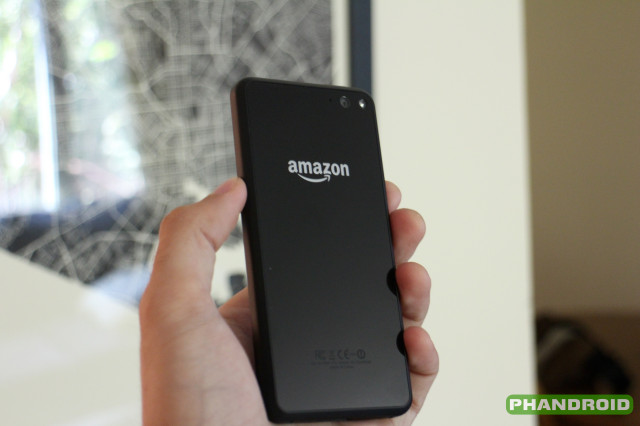
The Amazon Fire Phone is a device that aspires to be much more than it ever could be, falling short in so many areas while reserving the greatest attention to detail for features that could ultimately be written off as gimmicks. Dynamic Perspective and Firefly do add a unique angle to the phone, and they are neat in their own right, but it would be difficult to label them must-have features.
For the Android user, the Fire Phone is far from familiar and at times frustrating. For those looking for a fresh start with a new mobile OS, Amazon’s Fire OS still seems a bit half baked. For a device that seems to settle on nearly every aspect, hardware and software included, a price tag north of $600 is hard to justify, even with a free year of Amazon Prime thrown in.
At its best, the Fire Phone is an expensive experiment in merging the Amazon ecosystem with a smartphone form factor. At its worst, the handset is an average device limited by its reliance on the corporate hand it serves.
The Good
- Tight Amazon integration makes it a fine phone for accessing purchased media
- Dynamic Perspective offers an interesting, if not intuitive, take on navigating the phone’s interface
- Firefly works seamlessly and effortlessly to ID products, music, and more
The Bad
- Hardware is sluggish, software seems half baked
- No access to Google Play or Google services
- Battery life left us wanting more
Overall: 2.5/5







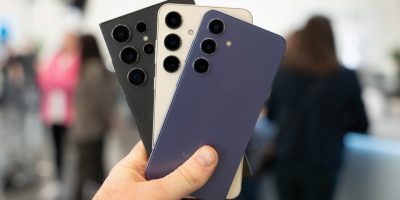

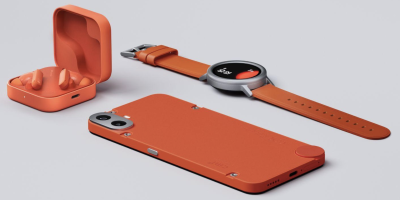
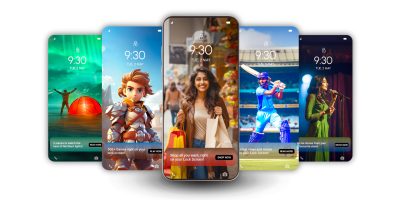





P.O.S and I dont mean point of sale
So what does it use for maps since it doesn’t have Google?
It uses Nokia’s HERE for maps.
http://here.com/
http://where.com ?
https://www.upthere.com/
Flop much?
What a piece of shyt!!!!
I like that you say that Dynamic Perspective is “unnatural, bad for battery life, most users will probably disable it, and will probably be scrapped in later versions” and then still put it in the “Good” category for the phone summary. It’s okay to let a flop be a flop.
Anyone wanna upload that awesome grey wallpaper?
Sluggish hardware should give the overall score 1/5, IMO. =T
You know it has some amazing idea’s just really hard to get into the market at this point. Even Amazon’s amazing ecosystem still makes it a tough sell.
The only way this would succeed is if they priced it *very* low. This is how they did okay with their tablet. For some people they decide based on price and assume that experience will be the same… they are wrong.
I checked out the phone in person at AT&T. I consider myself to be a HUGE Amazon fanboy, and I still wouldn’t buy this phone. I want to continue using Amazon by choice, not by force. As Robabobbob referred to, they should have taken a big loss on the hardware and made up the money via media and other purchases.
I did the same thing, and it was shocking how bad it was, its huge to have only 2400mah and 4.7inch screen, takes the prize from m8 for dat bezel. I was sad, i had high hopes, but the dynamic perspective is a gimmick at best, to tilt to scroll I had to tilt it past 90 degrees…at which point you cant see the screen and know when to stop. I didnt try firefly, because they setup the security cable over the camera…because all cellphone stores have incompetent demos.